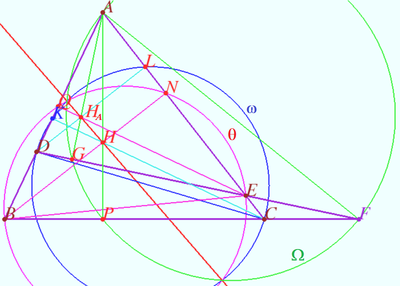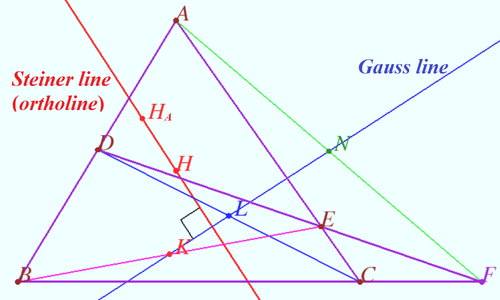Difference between revisions of "Complete Quadrilateral"
(→Newton–Gauss line) |
(→Newton–Gauss line) |
||
| Line 45: | Line 45: | ||
<i><b>Proof</b></i> | <i><b>Proof</b></i> | ||
| − | Points <math>K, L,</math> and <math>N</math> are the centers of circles with diameters <math>CD | + | Points <math>K, L,</math> and <math>N</math> are the centers of circles with diameters <math>BE, CD,</math> and <math>AF,</math> respectively. |
Steiner line <math>HH_A</math> is the radical axis of these circles. | Steiner line <math>HH_A</math> is the radical axis of these circles. | ||
Revision as of 16:18, 9 December 2022
Complete quadrilateral
Let four lines made four triangles of a complete quadrilateral. In the diagram these are ![]() One can see some of the properties of this configuration and their proof using the following links.
One can see some of the properties of this configuration and their proof using the following links.
Radical axis
Let four lines made four triangles of a complete quadrilateral. In the diagram these are ![]()
Let points ![]() and
and ![]() be the orthocenters of
be the orthocenters of ![]() and
and ![]() respectively.
respectively.
Let circles ![]() and
and ![]() be the circles with diameters
be the circles with diameters ![]() and
and ![]() respectively.
Prove that Steiner line
respectively.
Prove that Steiner line ![]() is the radical axis of
is the radical axis of ![]() and
and ![]()
Proof
Let points ![]() and
and ![]() be the foots of perpendiculars
be the foots of perpendiculars ![]() and
and ![]() respectively.
respectively.
Denote ![]() power of point
power of point ![]() with respect the circle
with respect the circle ![]()
![]()
![]()
![]()
![]()
![]()
![]() Therefore power of point
Therefore power of point ![]() with respect these three circles is the same. These points lies on the common radical axis of
with respect these three circles is the same. These points lies on the common radical axis of ![]() and
and ![]() Steiner line
Steiner line ![]() is the radical axis as desired.
is the radical axis as desired.
vladimir.shelomovskii@gmail.com, vvsss
Newton–Gauss line
Let four lines made four triangles of a complete quadrilateral.
In the diagram these are ![]()
Let points ![]() and
and ![]() be the midpoints of
be the midpoints of ![]() and
and ![]() respectively.
respectively.
Let points ![]() and
and ![]() be the orthocenters of
be the orthocenters of ![]() and
and ![]() respectively.
respectively.
Prove that Steiner line ![]() is perpendicular to Gauss line
is perpendicular to Gauss line ![]()
Proof
Points ![]() and
and ![]() are the centers of circles with diameters
are the centers of circles with diameters ![]() and
and ![]() respectively.
respectively.
Steiner line ![]() is the radical axis of these circles.
is the radical axis of these circles.
Therefore ![]() as desired.
as desired.
vladimir.shelomovskii@gmail.com, vvsss











